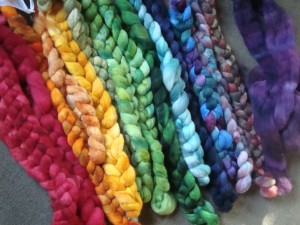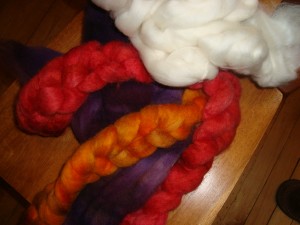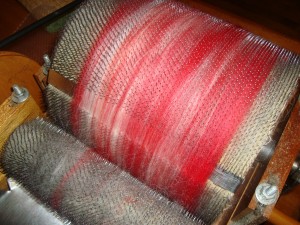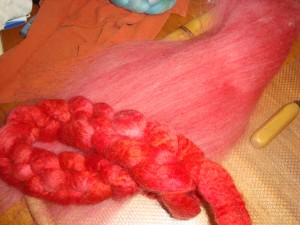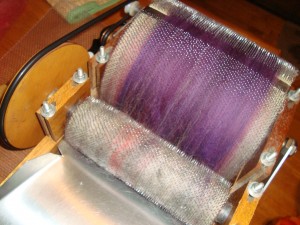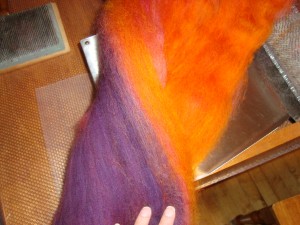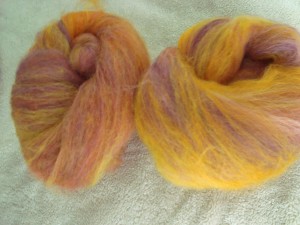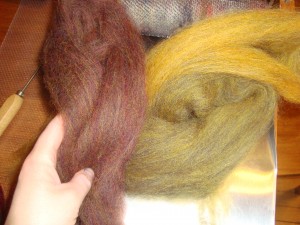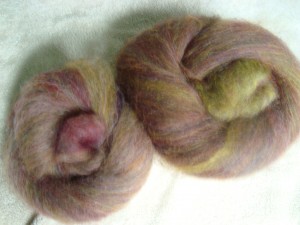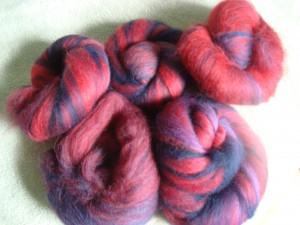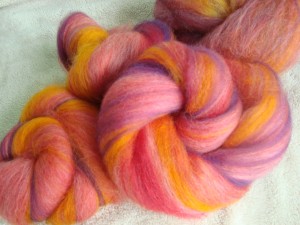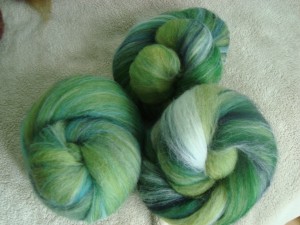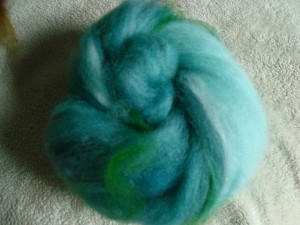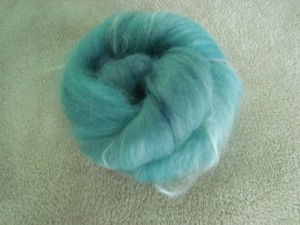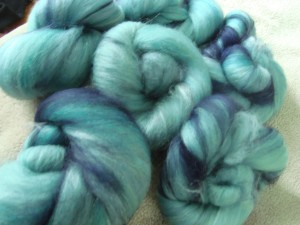Mon 7 May 2012
One of the terrible side effects of dyeing for sale is that every once in a while I end up with a shop reject. Maybe the fiber compresses too much and won’t fluff up again, or it breaks while I’m trying to braid it, or maybe it’s even a teeny little bit felted (I’m looking at you, Finn). I’ve never dyed anything that I won’t spin, but I’ve slowly been building up quite a collection of braids that I won’t sell, for various and sundry reasons.
Since many of these braids are a little denser or a little stickier than I’d like, they’re not really super fun to spin. They do make beautiful yarns though, so every once in a while I’ll pull one out and spin it up (that’s how the Striped Shawl Sweater began, if you recall…one 4 oz braid from the shop rejects bag).
However, it occurred to me that I currently have a drum carder. As I sat and processed through all that cream and gray, I started thinking about mixing color at the carder, and how carding the rejected braids might turn them into something more fun to spin. I certainly had a good range of colors, and I’ve never tried making blended batts, so this was a chance to learn something new. If I decide that I love to blend batts (and especially if I consider blending for sale in the future), that may also affect which kind of carder I want to buy, so this seemed like a good opportunity to nail down one of the parameters that I’ll need to consider when I do eventually get around to purchasing a carder of my own.
I gathered together a few colors that I thought would work well, and I started mixing.
I put the red on the carder first, and then layered on a bunch of white. Then I blended until I had a pretty even pink.
I put a layer of orange on the carder, then a layer of pink, and then covered it all up with a layer of purple.
That gave me a batt with three distinct layers of color.
Because I was experimenting, I passed it all through another time, which blended the colors together.
The colors ended up a bit more blended than I’d like, so I kept that in mind and moved on.
I also played around with mixing two very different colors; a deep navy blue and an almost orange gold. I was interested to see what these colors would do together, since it’s hard to dye such a high-contrast combination, and I thought this might be a way of mixing the two for an interesting yarn.
This experiment taught me that blending batts is far less forgiving than dyeing; I ended up with a pretty unattractive muddy green. I’ve found it almost impossible to get mud from my dyes, but blending at the carder is a lot more like mixing pigments than it is like dyeing, and there were a few combinations that I expected to work that flopped.
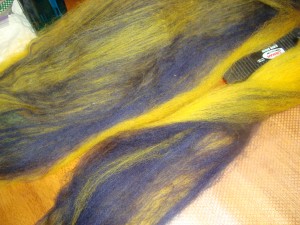
I kept this one as a reminder, but I also took a piece of it and kept blending and blending until it turned into a much more even green. Then I mixed some of that in with a red and blue mix that I didn’t love, and ended up with a very complex reddish-brown.
These still aren’t really my colors, but they do work well together. It’s almost like overdyeing; since all three colors have the same yellow (and two have the same blue), they match pretty well. Processed together, they made an interesting batt.
I wondered if maybe the yellow and blue had been too far apart in the color wheel, and so I did the same kind of blending with a red and blue instead, being careful not to overblend.
I do like these better, but I was beginning to suspect that I’d prefer mixtures that had one dominant color and a minimally blended stripe of an accent fiber, at least for the very bright colors that I had on hand. I would have liked to try “diluting” them down with browns, or grays or black to make a more subtle mix, but didn’t have any of those base colors on hand (and no, I wasn’t about to use my natural fleece for that!). I could dilute with white, but I’m not too big on pastel, so decided to work with a solid base color and minimal accents.
With that in mind, I revisited the purple, orange and pink combination from the top of the post, and ended up with this. See how those accent colors are  really just a very thin layer on top of the base pink? I assembled the batt in 4 layers (2 main color, 2 accent layers) to make sure there was some accent color in the body of the batt, but I think this proportion is a lot closer to what I’m going for.
I do like it quite a lot better than the first.
There really isn’t much of the accent colors in there, so it will be interesting to see how the colors work out when its spun up.
I liked that technique so much that I did it with a few more colors.
After all this testing, I was ready to try the mix I’d started out wanting to make.
I had a green and blue semisolid Polwarth that I snagged from the shop, and wanted to blend it with a sample of banana viscose that I bought on a whim a while ago. I thought that if I blended it with a little more green (BFL) and some Navy (Finn), I’d end up with the colors of the ocean, and the shiny viscose would be like the whitecaps. Again, this is something that would be very difficult to dye, because I wanted very fine stripes of pure white, and just a touch of the different accent colors, which is almost exactly what I got.
I decided that the first one was a little overblended, so I adjusted my method yet again and finished up the 4 oz.
It looks like I made a ton of fiber, but actually I probably only have about 12 oz of batts. This carder seems to fit about an ounce per batt, and sometimes a little more depending on the fiber. It really didn’t take much wool to experiment, and it converted some less-than-exciting leftovers into something I can’t wait to spin. I’ve never spun a blended batt before; have you?
